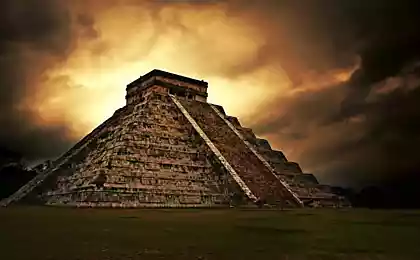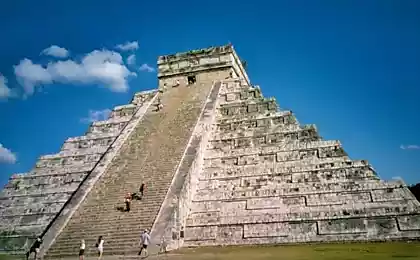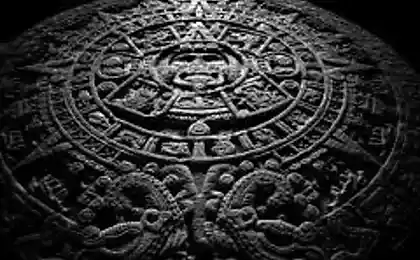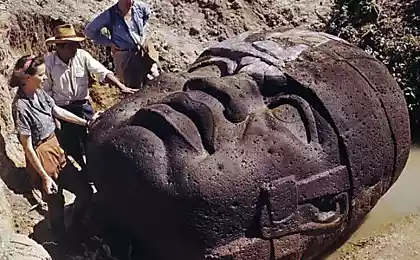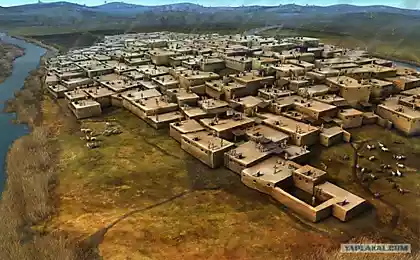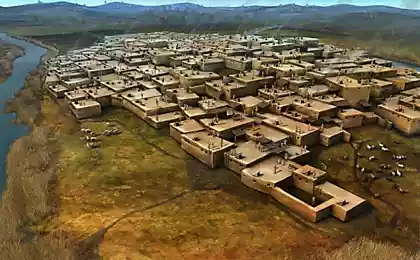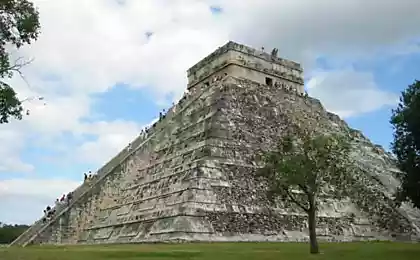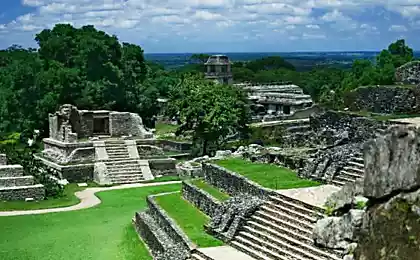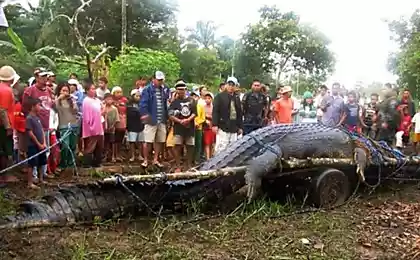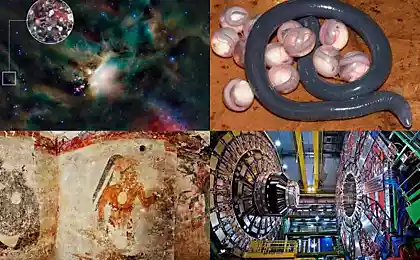783
Find the cause that led to the death of the Mayan civilization 1,000 years ago!
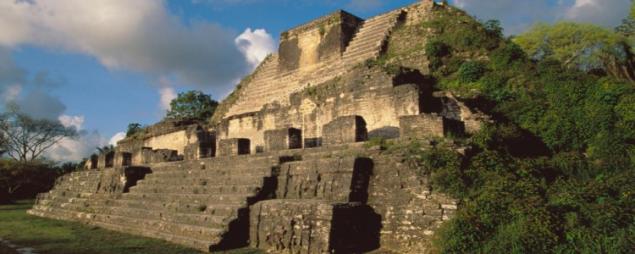
When the Spanish conquistadors sailed to Central America in 1517, their goal was the destruction of the Mayan civilization. But the arrival of the colonizers found that much of their work has been done to them. Impressive limestone of the city - a classic feature of one of the most advanced societies of antiquity - is overgrown with jungle
. The question of how the Maya met their end, remains one of the most enduring mysteries of history. Maya people survived; they even managed to organize a long-term resistance to the European aggressors. But by the time the Spaniards landed, political and economic force that has built the famous pyramids in places and supported a population of two million, has already disappeared.
The first foundation of the Maya laid in the first millennium BC, and the development of civilization has reached a peak around the year 600 BC. e. The chronology of the Maya of Mesoamerica are located between the first and later the Aztecs the Olmecs. Archaeologists have found thousands of ancient Mayan cities, most of which were scattered around the yuzhnomeksikanskomu Yucatan Peninsula, Belize and Guatemala.
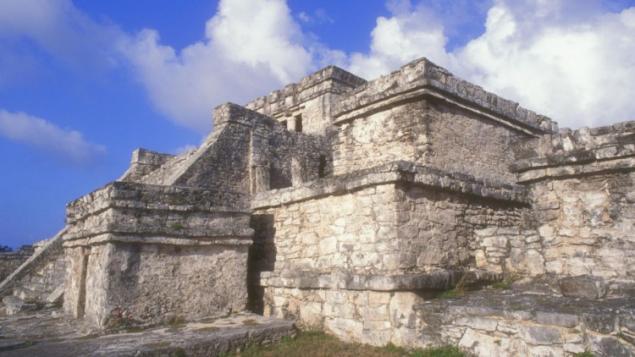
Most likely, more Mayan ruins is under thick tropical forests.
Approximately 200 years later serious archaeological research, we have learned enough about the Mayan civilization, to admire her. Their distinctive art and architecture showed that they were a people of beautiful crafts.
Maya was also intellectually advanced. They were well aware of the math and astronomy, using them to align the pyramids and temples according to the precession of the planets and the solar equinox. And they used the only known written in Mesoamerica, quaint-looking character set, Maya hieroglyphs.
Miracles left Maya, provided them with a mystical aura. But lost civilization - this is the real mysticism, in every detail. And, it seems, we understood why the Maya came to an end.
Let's start with what we know. Somewhere in the year 850 BC. e., after centuries of prosperity and dominance, the Maya began to leave their great cities, one after another. Less than a fraction of the former reached 200 years of greatness of civilization. There were isolated settlements, but the Maya heyday era gone forever.
In addition to the tragic extent of the decline of the Maya, despite decades of research, archaeologists still do not know what caused it. As is the case with the Roman Empire, the originator of civilization fall was clearly not alone. But the pace of the Mayan death has led some scientists to conclude that the cause was a major disaster, capable of destroying the city one by one on your way.
There are many theories that marked the end of the Maya. Among them are old and well-known - the invasion, civil war, the loss of trade routes. But since climate records were compared in Central America in the early 1990s, one of the theories became especially popular: the Mayan civilization was doomed due to the serious climate change
.
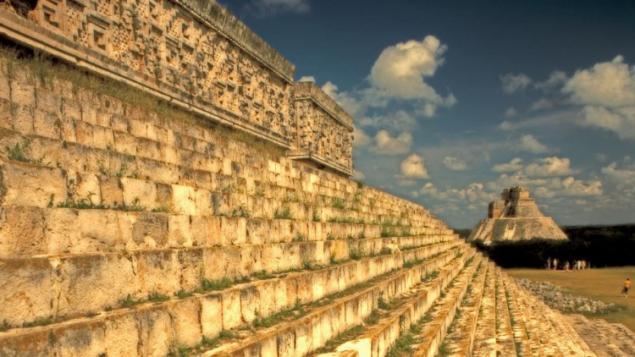
In the century just before the collapse of the Maya - the so-called "classic era" with 250 800 AD. e. - Civilization humming. City flourished, the harvest was rich. Climate Records (which are taken mainly from the analysis of cave formations) have shown that during this period in the territory of the Maya spilled relatively heavy rainfall. But those same records show that in about 820 AD. e. in the region hit 95 years of intermittent droughts, some of which lasted for many decades.
Since the drought have been identified for the first time, scientists noticed a striking correlation between their terms and the collapse of the Maya. Although only one correlation is not enough to close the issue, a close link between drought and a fall led experts to believe that the climate shift of the 9th century could somehow cause the decline of the Maya.
However, no matter how attractive any explanation of drought, it is not enough. Because not all Mayan city fell with climate draining.
Mayan Cities, which fell during the drought of the 9th century, mainly located in the southern part of its territory, in place of modern Guatemala and Belize. On the Yucatan Peninsula in the north, however, the Mayan civilization has not only survived the drought, but also flourished. This revival of the northern puts a stick in the wheel of the drought theory: if South paralyzed climate shift that happened with the north
? We offer different explanations for this discrepancy between the north-south, but so far no theory did not win. However, the recent discovery could shed light on this paradox everlasting.
Archaeologists Maya barely recovered data. Virtually no written records of the Maya, who once were thousands did not survive the colonial times (on the order of Catholic priests Spaniards burned the books of the Maya piles - known of the remaining four in total). Instead, to determine the time of flourishing of the ancient Maya, scientists rely on the calendar entries on stone monuments, stylistic analysis of Mayan pottery and radiocarbon dating of organic materials.

Previous studies have already identified the approximate age of the main urban centers in the north of the Mayan civilization; it turned out that the north has experienced drought 9th century. However, until recently, the data sample is never collected in one study. And to do this it is important, because you can look at the northern Maya in general, and already the basis of this to determine the overall trend of ups and downs.
In a study published in December, archaeologists from the US and the UK for the first time brought together all the calculated age of the urban centers of the northern Maya lands. 200 date from places all over the peninsula of Yucatan, received half of the entries stone calendars and half of the radiocarbon dating were collected. Then the scientists have managed to create a broad picture of the time when they were active northern city of Maya, as well as the time when each of them could sink into oblivion.
What researchers found significantly change our understanding of when and perhaps why Maya civilization came to an end. Contrary to previous opinion, the north fell into disrepair during the drought - actually, two of them he suffered
. Stone annals showed that in the second half of the 9th century there was a 70 percent decline in the activity of the Mayan cities. This rate of decline echoed in radiocarbon dating on the northern Maya region: construction of wood was reduced during the same period. What is important, at the same time, the drought destroyed the Mayan civilization in the south - and this has not gone unnoticed for the north
.
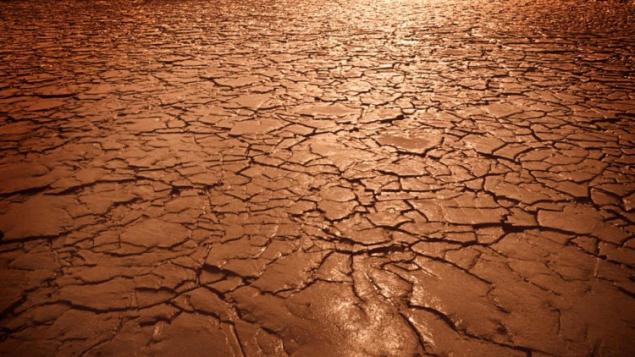
Scientists believe that the creative activity of extinction indicates political and social collapse, which occurred in the north. North definitely felt better in the south of the 9th century, but recent evidence suggests that the region still experienced significant fading. Previously, it could not be found due to the delicate nature of the event: decline in production, even large-scale, difficult to detect without a comprehensive, region-wide analysis carried out new research
. The decline of the north in the 9th century - an interesting detail the history of the Maya, but nothing fundamental in it there - after all, we already knew that the northern Maya experienced drought 9th century (Chichen Itza and other centers flourished in the 10th century)
.
Still, scientists have identified a second decline, which changed our understanding of Maya history. After a brief recovery during the 10th century (which, interestingly, coincides with an increase in rainfall), the researchers noticed another sharp decline in production in many places in the northern area of the Maya: stone carving and other construction activity fell by almost half from 1000 on 1075 g . n. e. Moreover, during the crisis 200 years ago, scientists found that the decline of the Maya of the 11th century took place against the backdrop of a severe drought.
And not just drought. Droughts 9th century were certainly serious. But the 11th century brought the worst drought the region for 2000 years - "megazasuhu»
.
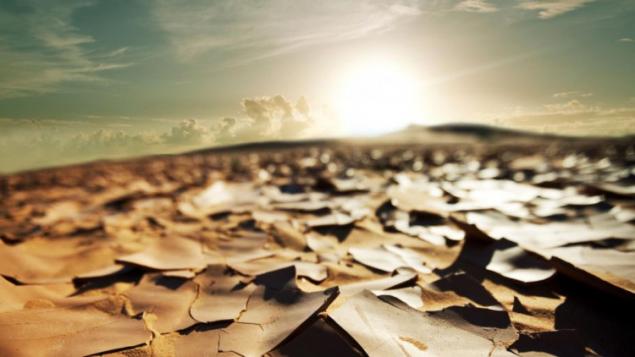
After a brief recovery was a decline in production in the north - on the background of drought. Climate data shows that rainfall decreased most of the century, to 1020 in 1100, just at the same time, when there was a collapse of the northern Maya. One correlation itself does not mean much. But the two made even skeptics to believe in this cause.
Megazasuha 11th century previously cited as a cause of the fall of the northern Maya, but the old dating methods do not allow to clearly identify whether the two events overlap. A detailed analysis, published in December, allowed us a certain confidence to say that climate change is caused not one but two periods of Mayan decline.
The first wave of drought put an end to the Maya to the south, and the other, apparently, sentenced them to the north.
After the second wave of the Maya droughts have not recovered. Chichen Itza and most important centers of the north has never bloomed. There are several departures - as the northern city of Mayapan, which flourished in the 13-15 centuries - but they can not be compared in size and complexity with the cities of the Classic Maya. In many ways, the 11th century was the last gasp of the Maya.

It seems that climate change played a major role in the collapse of the Maya. But why?
Much of the explanation for the collapse of archeologists includes agriculture. Maya, as well as all major civilization, largely depended on the harvest of its economic success - and, of course, in the maintenance of its huge workforce. The simplest explanation for the decline of the Maya would be an annual reduction in yield caused by drought that gradually reduced the political influence of the Maya and eventually led to a complete social disintegration.
But even supporters acknowledge drought hypothesis that the picture should be much more.
"We know that on the territory of the Mayan military grew and socio-political instability due to droughts 9th century", - says Julie Hoggart from Baylor University in Waco, Texas, who participated in the December climate analysis
. Intercity conflict - is also a good way to destroy civilization; maybe the Mayans simply killed each other. Perhaps all this proceeded against the backdrop of a severe drought. As food supplies decreased during the dry decades, the struggle for resources became more intense and led ultimately to a turning point, when the civilization of the ancient Maya was irreparably fractured.
There is also at least one explanation, which does not require any military action. Perhaps doomed to destruction of the Maya are not warriors, and talents. Because the Maya were excellent craftsmen and environmental sculptors.
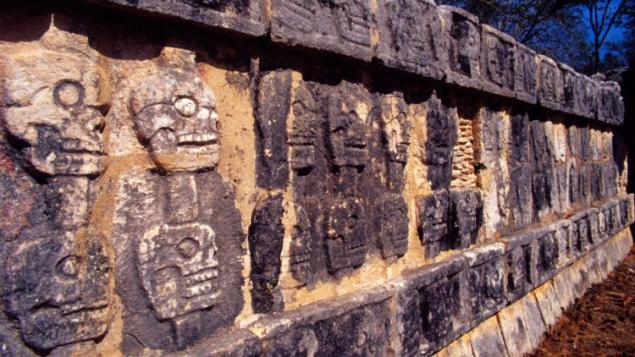
To grow enough food and feed their millions, the Maya dug a huge system of channels, sometimes hundreds of kilometers wide, which allowed them to drain wetlands and raise the badlands, in the territory of the Maya had many, making them arable land. Some archaeologists call them "floating gardens". Maya also cleared huge areas of forest for agriculture, and for their cities.
Some scientists believe that good environmental management might cause further collapse of the Maya, for example, due to the deterioration of the natural environment. Some scientists believe that deforestation to clear land for agriculture could lead to local effects of drought, which worsened during the extensive drought.
An indirect consequence of their agricultural woes may be that they allowed their populations become too large, and a large population is vulnerable to a sustained reduction of food stocks.

Whatever the reason - or reasons - the fall of the Maya, we know something about the fate of people who stayed with the consequences of all this. Since 1050 BC. e. Maya took to the road. They left the interior of the land on which their ancestors had thrived, and headed towards the Caribbean coast or to other water sources, lakes and rivers.
The outcome of the Maya people could be motivated by hunger. If the crops are really killed after droughts 9 and 11 century, the transition to a place rich in water, made sense as an immediate access to the sea food and fertile land by the sea. Whatever the reason, the Maya walked to moisture.
But, again, it has always been. One of the duties of the Maya rulers had communication with the gods, who provided a wet year and good harvests. In locations around the Mayan world, archaeologists have raised the bones of people from the bottom of lakes and craters - were considered doors to the underworld: it eloquently proves that people were sacrificed to the gods to have mercy. When the rains were good and civilization flourished, it was clear that the Mayan prayers heard.
But the gods have turned away from the Maya.
: Hi-news.ru
Loading ... Loading ... Loading ...
Liked? Share with your friends!
Loading ... Loading ...
The couple thought that they took Average Kitten. They did not know how much mistaken.
It uses the Muslim hijab, for transformation into Disney Princesses
